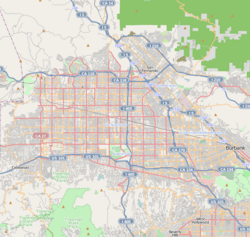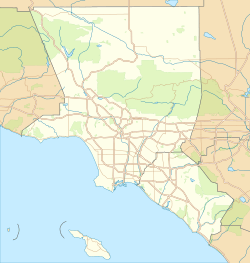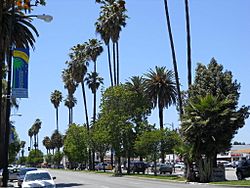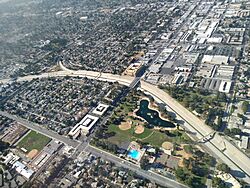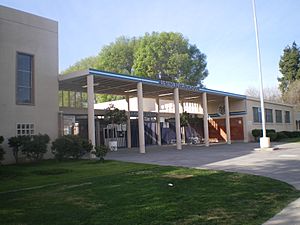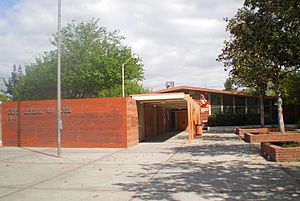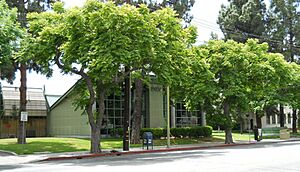Reseda, Los Angeles facts for kids
Quick facts for kids
Reseda
|
|
|---|---|

Boundaries of Reseda from an illustration by The Los Angeles Times
|
|
| Country | United States |
| State | California |
| County | Los Angeles |
| City | Los Angeles |
| Named for | Reseda odorata |
| Population
(2010)
|
|
| • Total | 74,363 |
Reseda is a neighborhood located in the San Fernando Valley part of Los Angeles, California. It was started in 1912. The main shopping area began to grow in 1915. For many years, Reseda was a farming community. The area was hit by earthquakes in 1971 and 1994.
Reseda has 15 public schools and five private schools. The community also has public parks, a center for older adults, and a large library.
History
How Reseda Started and Grew
The land where Reseda is today was once home to Native Americans from the Tongva tribe. They lived near the Los Angeles River.
In 1909, a group of people bought a large area of land. This group included important figures like Harry Chandler and H.G. Otis. They planned new towns, including Marian, which is now Reseda. Los Angeles officially took over these rural areas in 1915.
Reseda began in 1912 as a town called Marian. It was named after Marian Otis Chandler. She was the daughter of the Los Angeles Times publisher. The name Reseda comes from a sweet-smelling plant called Reseda odorata. This plant, also known as mignonette, grew commonly in gardens there.
The name "Reseda" was first used for a train stop. This stop was on a branch of the Southern Pacific Railroad. This railway connected Burbank and Chatsworth. Later, the name was used for a stop on the Pacific Electric Railway "Red Cars Line." This train line helped the area grow quickly.
The town was still called Marian for a while. But in 1921, a new post office was needed. The town's name had to change to avoid confusion with other places. Ninety-two residents met and decided to rename the town Reseda. The new post office opened on July 1, 1922.
The main business area of Reseda started in 1915. This was at the corner of what is now Reseda Boulevard and Sherman Way. A hardware store was built first. Soon, other shops like a blacksmith and a grocery store followed. Sidewalks and paved roads were added between 1918 and the early 1920s. In 1929, Reseda Avenue was renamed Reseda Boulevard.
Reseda grew slowly at first. The Great Depression in the 1930s slowed its growth even more.
During the late 1920s and 1930s, Reseda became known for its farms. It produced lettuce, lima beans, and walnuts. By the late 1930s, it was one of the biggest lettuce producers in the country. Trains would come daily to pick up cars full of lettuce. Other businesses, like making roof tiles, also started to grow.
Reseda After World War II
Reseda stayed mostly a farming community. In 1930, about 1,800 people lived there. By 1940, the population grew to over 4,000. In the mid-1940s, many single-family homes were built. This meant that much of the farmland was replaced by houses. Reseda became one of the first suburbs in the San Fernando Valley.
Large farms were divided into smaller plots. Real estate agents developed these areas for soldiers returning from World War II. The orange groves were plowed under to make way for new homes. Most jobs at that time were in the Los Angeles Basin.
By 1950, Reseda had over 16,000 residents. In the early 1950s, the population grew very quickly. Reseda became one of the most popular communities in the Valley. Local shops even offered bus service to help shoppers get around.
In the 1970s, the value of homes and incomes in Reseda started to go down. Land and housing costs went up, but most people's incomes did not keep up. By the early 1980s, the average home price in the Valley was about $110,000.
The Northridge Earthquake
The 1994 Northridge earthquake happened at 4:31 AM on January 17. It measured 6.7 on the moment magnitude scale. This earthquake was very strong. It was the only large earthquake in modern times to happen directly under a major U.S. city. It was also the most damaging earthquake in the U.S. since the San Francisco Earthquake of 1906. The earthquake's center was just west of Reseda Boulevard.
This was the second strong earthquake to affect the area in 23 years. On February 9, 1971, the San Fernando earthquake (also called the Sylmar earthquake) hit with a magnitude of 6.5.
Geography
Reseda is surrounded by other neighborhoods. To the north is Northridge. To the east is Lake Balboa. To the south are Tarzana and Encino. To the southwest is Woodland Hills. To the west is Winnetka. Its main street borders are Roscoe Boulevard on the north, White Oak Avenue on the east, Victory Boulevard on the south, and Corbin Avenue on the west.
| Climate data for Reseda, Los Angeles | |||||||||||||
|---|---|---|---|---|---|---|---|---|---|---|---|---|---|
| Month | Jan | Feb | Mar | Apr | May | Jun | Jul | Aug | Sep | Oct | Nov | Dec | Year |
| Mean daily maximum °F (°C) | 67 (19) |
69 (21) |
71 (22) |
77 (25) |
80 (27) |
87 (31) |
93 (34) |
95 (35) |
90 (32) |
83 (28) |
74 (23) |
68 (20) |
80 (27) |
| Mean daily minimum °F (°C) | 42 (6) |
43 (6) |
44 (7) |
46 (8) |
50 (10) |
54 (12) |
58 (14) |
59 (15) |
56 (13) |
51 (11) |
44 (7) |
41 (5) |
49 (9) |
| Average precipitation inches (mm) | 3.95 (100) |
4.16 (106) |
3.53 (90) |
0.83 (21) |
0.29 (7.4) |
0.06 (1.5) |
0.01 (0.25) |
0.16 (4.1) |
0.27 (6.9) |
0.57 (14) |
1.38 (35) |
2.14 (54) |
17.37 (441) |
People in Reseda
In 2010, about 74,363 people lived in Reseda. The average age was 35.5 years old. The average household income was $53,842 per year.
A 2008 study showed that Reseda has many different ethnic groups. About 43.5% of people were Latino. About 37.2% were Non-Hispanic white. About 11.2% were Asian. About 4.2% were black. The rest were from other groups. Many residents were born outside the U.S., mostly from Mexico and El Salvador.
In 2010, about half of the homes were rented (48.5%). The other half were owned by the people living in them (51.5%).
Education
About 19% of adults in Reseda (age 25 and older) had a four-year college degree by 2000. This is about average for Los Angeles. Many residents also have a high school diploma.
Here are some of the schools in Reseda:
Public Schools
- Reseda High School, 18230 Kittridge Street
- Grover Cleveland High School, 8140 Vanalden Avenue
- Miller Career and Transition Center, 8218 Vanalden Center (for special education)
- Cantara Street Elementary School, 17950 Cantara Street
- Blythe Street Elementary School, 18730 Blythe Street
- John R. Wooden High School, 18741 Elkwood Street (a continuation school)
- James Jordan Middle School, 18600 Lanark Street
- Melvin Avenue Elementary School, 7700 Melvin Avenue
- Garden Grove Elementary School, 18141 Valerio Street
- Sven Lokrantz Special Education Center, 19541 Wyandotte Street
- Reseda Elementary School, 7265 Amigo Avenue
- Magnolia Science Academy 1, 18238 Sherman Way
- Magnolia Science Academy 5, 18230 Kittridge Street
- Diane S. Leichman Special Education Center, 19034 Gault Street
- Bertrand Avenue Elementary School, 7021 Bertrand Avenue
- Reseda Community Adult School, 18230 Kittridge Street
- Newcastle Elementary School, 6520 Newcastle Avenue
- Shirley Avenue Elementary School, 19452 Hart Street
Private Schools
- Applied Scholastics Academy Valley, 19000-A Saticoy Street
- Saint Catherine of Siena, 18125 Sherman Way
- Heart of the Valley Christian School, elementary, 18644 Sherman Way
- Kirk o' the Valley (Elementary) School, 19620 Vanowen Street
- Trinity Lutheran High School, 7357 Jordan Avenue
School Changes
In the 1980s, some schools like Garden Grove Elementary and Newcastle Avenue School were closed. This happened because many parents took their children out of the public school system. Later, these schools were reopened. This was due to new programs to reduce class sizes. Also, more new families were moving into the area, which increased student numbers.
Fun Places to Visit
The Reseda Country Club was a famous concert place in the 1980s. Many popular bands played there, like U2, Culture Club, and Tom Petty & the Heartbreakers. It was also used for boxing matches. Today, it is a Spanish-language Christian church.
The Reseda Theater, located at 18443 Sherman Way, was built in 1948. It closed in 1988. You can see its outside briefly in the movie Boogie Nights.
Parks and Recreation
- Reseda Park and Recreation Center has many fun things to do. There are barbecue areas, a baseball field, basketball courts, and a playground for kids. It also has a community room, picnic tables, a swimming pool, and courts for tennis and volleyball. The park has a lake for fishing and a large duck pond.
- Reseda Senior Multipurpose Center is a place for older adults to gather.
- Randal D. Simmons Park is a large park next to the West Valley Regional Library. It has picnic areas, walking paths, shade trees, and a playground. It is named after Officer Randal D. Simmons.
- West Valley Family YMCA offers classes and has a soccer field, playground, daycare, and swimming pool.
- Reseda Blvd. has the longest protected bike lanes in Southern California. In March 2024, it hosted a special biking event called Ready for Reseda.
Libraries
The West Valley Regional Branch Library is run by the Los Angeles Public Library. It is a great place to find books and learn new things.
Famous People from Reseda
- Martin Donovan (born 1957), an actor in movies, plays, and TV shows.
- Gabe Kapler (born 1976), a former Major League Baseball player and manager for the San Francisco Giants.
- Kyle (born 1993), a rapper, singer, songwriter, and actor.
- Donald D. Lorenzen (1920–80), a Los Angeles City Council member.
- Jim Robinson (1946–1995), a racing car driver.
- Fredo Santana (1990–2018), a rapper.
- Zachary "Kid Yamaka" Wohlman (born 1988), a professional boxer.
- Ana Kasparian (born 1986), a political commentator.
- Corey Feldman (born 1971), an actor.
See also
 In Spanish: Reseda (Los Ángeles) para niños
In Spanish: Reseda (Los Ángeles) para niños


